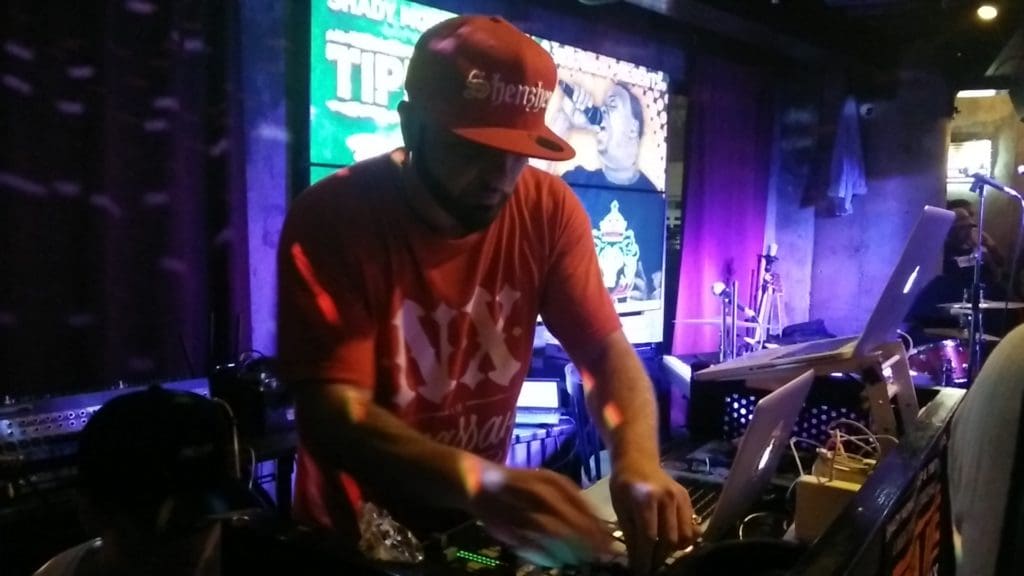After the interview with DJ Mefaun Rice scratched the surface of Shenzhen’s hip-hop scene, I remembered my second sighting of hip-hop subsequent to my arrival (the first was a b-boy practicing in Lizhi Park), it was in the form a flyer being passed around group chats on WeChat. The promotional was for a Shady Monkey Hip Hop party. Months later, I saw the third hip-hop sighting and it was SMHH again asking for people to join the shooting of their music video parodying O.T. Genasis’ “CoCo” called “I’m in love with the Baijiu”. If you don’t know what baijiu is, it’s a Chinese liquor that’s not for the faint hearted.
So, I met up with two members of Shady Monkey Hip Hop at a fancy wine and dine spot called, SHARK in Futian’s CoCo Park. Group member Maffiuletti “DJ Mafio” Alessandro, 43, was supposed to perform later in the evening, so 29-year-old Ahmad “MC Skezz” Owaisi suggested that the three of us meet up before Mafio’s set.
Skezz arrived first in all dark attire: a black fitted cap, a puffy jacket, and slightly baggy yet well-suited jeans. He hugged the restaurant manager while giving a few nods to guys seated throughout the patio; one of those nods was to Hong Kong DJ and international graffiti artist named Ceet, who was out celebrating his birthday. It was clear Skezz was no stranger to that area.
Skezz came to Shenzhen in 2014 from Jordan where he was running his own hip-hop label called Gorilla Freaks Productions that supported local talents around the Middle East. He immediately started looking for traditional work and music opportunities. While he was at a job interview he met a woman who connected him to Usana “Shady” Shadday, 37, from San Francisco (the originator of SMHH). At the time, Shady was throwing his third hip-hop party that featured breaking, MC battles, and DJ Mafio. The party marked the birth of what SMHH is now, according to Shady.
The first song the group released was “Shenzhen”, a tribute to the city that has been making things happen for these men.
“Mafio’s in the house!” Ceet chimes as Mafio emerges.
Mafio strolled in matching Skezz’s look but with a bit more shine; a ring that represented his Chinese zodiac sign had a decorative face of a tiger as the head. The first of SMHH to arrive onto the Shenzhen hip-hop scene was Mafio back in 2004. After leaving his home in South Switzerland, Shenzhen was the third inhabitable place on his list after Jamaica and Thailand. He started disc jockeying at True Colors “ on the 25th floor” (a small detail that distinguishes it from other homonymous bars). True Colors was “famous for music – real music – not like commercial things for KTV,” Mafio mentioned. Apparently, during this time clubs in Shenzhen only played up “KTV music” or Chinese disco.

“The music in 2004, it was completely far away from what it is now, I saw some evolution. I didn’t see much evolution, but I saw some evolution,” said Mafio. “I mean now you can choose where to go.” With the opening of Galaxy’s CoCo Park around 2006, the club scene broadened, which simultaneously lead to an expanse in the music scene’s visibility since there was a more centralized location for clubgoers of all nationalities and DJs.
In 2012, Shady, who isn’t a musician but organizes a lot of the SMHH events, settled into Shenzhen after years of commuting back and forth from the States to work on publishing projects. For Shady, the music scene wasn’t to his liking either.
“It was mostly like electronic music and like a lot of techno. There were underground people doing drum and bass parties, but that’s not really like my music. I love hip-hop, I love reggae.”
After witnessing his friend’s unsuccessful techno parties, Shady was inspired to try a hip-hop party and used his Chinese zodiac sign, the monkey, as the logo. With each party that succeeded the last, the crowds grew and grew.
“We started building up the brand until we became an official hip-hop movement in Shenzhen over here,” said Skezz.
Don’t get any of this wrong, hip-hop was definitely on the scene before SMHH (as a later interview with local rapper JR Fog will highlight). A club called Public is run by Micheal Fat Way and has been a haven for hip-hop lovers. On top of that, Shenzhen has been hosting China’s annual hip-hop music awards show for a few years now.
But the underground events and parties weren’t bringing foreigners and locals together and putting them in the same venues like it visibly does now. And the guys proudly admit how instrumental they were in its manifestation.
“I’m sure before us you couldn’t find hip-hop music [parties]. Since we started to do our parties… since people started to follow us, now even in the club you can find hip-hop music,” states Mafio. The guys gave the example of a popular bar called Sicilia’s that supposedly began to spin hip-hop jams into their sets after witnessing the success of SMHH’s parties.
“People build up on a lot of what we’re doing over here. They started doing a lot and they started changing a lot.”
Despite the upgrade, the artistry of hip-hop will continue to be censored. Chinese hip-hop artists who want their work published and openly marketed must have it reviewed word-for-word by the government. In actuality, this process applies to Chinese musicians in general and anyone who wants to perform in the Middle Kingdom. Nothing politically or culturally sensitive; and nothing with sexism, racism, or any kind of language that is or could be considered inappropriate. A step above the U.S.’s Parents Music Resource Center’s (PMRC) “Parental Advisory” and “Explicit Lyrics” labels that used to seal CDs, once upon a time.
Somewhat, like-minded writer Bailey Hu touched on the differences with Chinese hip-hop in her piece for ChinaSquat, “…it would be a mistake to instantly write off Chinese rappers who don’t rant against The Man or brag about how ‘hood’ they are. With a definite lack of the gun violence and drug use that has inspired a lot of popular American rap, for some Chinese musicians it might just make sense to talk about other things that are more relevant to their lives.” In spite of the fact that Hu seems to have forgotten about how a fresh prince’s life got flipped upside down for a good portion of the 90’s and the fact that Chengdu rapper Fat Shady referred to China as one big trap house, her comment shares an attitude towards hip-hop that many hip-hop loving Shenzheners are trying to disrupt.
The guys were recruited to do a promotional performance of the ELEMENTS of hip-hop by the local government. The event took place the day after the local authorities raided a rave in a tunnel, which caused a bit of nervousness as the group worked to make sure that attendees got a real clean look at hip-hop, you know, the side that doesn’t involve the cliché associations like illegal drugs, guns, misogyny, and drinking.
“This one talks about pussy – no, this one talks about money and b*tches-no!” said DJ Mafio as he recounted his song selection process for the event. “Ok, De La Soul. Ok, A Tribe Called Quest…”
Outside of their public performances, SMHH says they want to “show people what hip-hop is about.” Skezz admitted that he has had to review the music of guest performers and mention something that would make DOPE’s Diggy a bit proud, “don’t say the n-word in your song.” He says the instruction is a way of preventing misunderstandings and educating local artist on the weight and complexity of the word being said to naive individuals or folks who just ain’t havin’ it.
Providing a bit more context to hip-hop lingo is just one piece of how SMHH has shown support to local artists. The guys say they provide platforms for aspiring rappers to produce music, perform at their events, and even appear in their music videos, like 19-year-old Wen “Artist Gun” Yin Hao (AG for short) who was featured on their song “Old School.”
“Shady Monkey can give me more [of a platform] and more shows,” said AG who’s been rapping since he was 15, but has only known the guys for about two years.

Even though SMHH works to cultivate the hip-hop movement and keep the community bridged, they have no interest in influencing the hip-hop scene.
“We just do what we like,” Shady adds, “I mean there’s greater people who can influence.”
“I just play what I really love. What I love is not commercial, it’s really really hip-hop, you know. It can be hip-hop, dancehall, or reggae music – it’s my style,” said Mafio.
SMHH provided their interpretation of hip-hop music in Shenzhen and how they’ve catered to the mixed audiences that attend their events. What’s more interesting is that for these guys doing what they love has worked out for them and has made an impression on local businesses who now open their sound systems to hip-hop. These guys participated in laying the foundation for what will come in the future for Shenzhen’s music scene.

